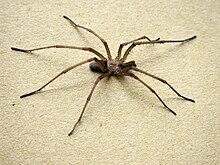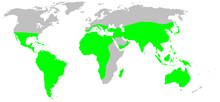|
Crevice weaver
Crevice weaver spiders (Filistatidae) comprise cribellate spiders with features that have been regarded as "primitive" for araneomorph spiders. They are weavers of funnel or tube webs. The family contains 18 genera and more than 120 described species worldwide. One of the most abundant members of this family in the Americas is the southern house spider (Kukulcania hibernalis). Named after the fierce Meso-American god Kukulkan, the females are large (up to nearly 20 mm) dark-colored spiders and males are light brown, smaller (about 10 mm), but more long-legged and with palps that are held together in front of their carapaces like the horn of a unicorn. The males also have a darker streak on the center of the dorsal carapace that causes them to be often mistaken for brown recluse spiders. The tiny members of the genus Filistatinella are like miniature versions of Kukulcania. The nominate genus Filistata is Afro-Eurasian in distribution. In many older books the species from the Americas now placed in the genus Kukulcania are placed in Filistata. A striking visual characteristic of the family, beside dimorphism, is the unusual upward bend encountered near the femur of the first pair of legs. While resembling hydraulic muscle mechanisms akin to arthropods, this modification actually allows the spider to retain the prey directly from the crevice it occupies. Also, if the larger prey ever tries to pull it from the crevice, the spider can use these legs to "grab" to the side walls and hence make it difficult. Many Kukulcania species also use them to dig holes in the soft ground at a 25- to 30-degree angle.[citation needed] TaxonomyThe family Filistatidae was created in 1867 by Anton Ausserer.[1] It was based on the species he called Filistata bicolor (now Filistata insidiatrix), a Mediterranean species also found in southern Austria.[2][3] PhylogenyOn the basis of the features of the male and female genitalia, the family was placed in the Haplogynae, usually as the sister taxon of the remaining members of the group.[4] However, unlike the other haplogynes, Filistatidae are cribellate and do not show a decrease in the number of segments of the anterior lateral spinnerets.[5] They have other features which have been regarded as "primitive": an M-shaped intestine, only leg IV moving while combing silk, and posterior book lung leaves being present in early juveniles.[6] A 2013 study based on molecular evidence placed the family as sister to a clade consisting of Hypochilidae and the remaining haplogynes.[7] The precise phylogenetic position of the family was described in 2014 as "one of the most enigmatic problems in spider phylogeny".[5] A 2015 study, based on genomic data, places Filistatidae with Hypochilidae in a clade outside most of the families previously placed in Haplogynae:[8]
This placement suggests that features that were thought to be "primitive" to araneomorph spiders as a whole (such as an M-shaped midgut) could actually be novel derived features (synapomorphies) of the Hypochilidae-Filistatidae clade.[8] GeneraAs of April 2019[update], the World Spider Catalog accepts the following genera:[9]
See alsoReferences
Wikispecies has information related to Filistatidae. Wikimedia Commons has media related to Filistatidae. |
|||||||||||||||||||||||||||||||||||||||||||||||||||||||||||||||



